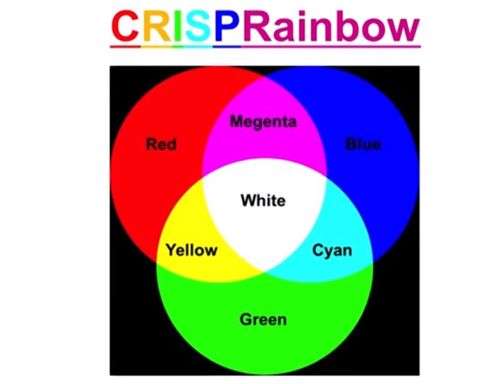Scientists develop multicolored labeling system to track genomic locations in live cells

CRISPRainbow, a new technology using CRISPR/Cas9 developed by scientists at UMass Medical School, allows researchers to tag and track up to seven different genomic locations in live cells. This labeling system, details of which were published in Nature Biotechnology, will be an invaluable tool for studying the structure of the genome in real time.
"Most people are using CRISPR for editing genomes. We are using it to label DNA and track the movement of DNA in live cells," said research specialist Hanhui Ma, PhD, who coauthored the study with Thoru Pederson, PhD, the Vitold Arnett professor of cell biology and professor of biochemistry and molecular pharmacology.
Knowing the precise location of genomic elements in live cells is critical to understanding chromosome dynamics because the genes that control our biology and health do so according to their location in 3-dimensional space, said Drs. Pederson and Ma. For a gene to be transcribed and expressed, it must be accessible on the chromosome. Where DNA is positioned in the crowded nucleus plays an important role in everything from embryonic development to cancer.
Current technologies, however, are only capable of following, at most, three genomic locations at a time in live cells. Labeling more sites requires that cells be fixed by bathing them in formaldehyde, thus killing them and making it impossible to observe how the chromosome's structure changes over time or in response to stimuli.
To overcome this technological hurdle, Pederson and Ma turned to CRISPR/Cas9. To tag specific locations along the genome using the CRISPR/Cas9 complex, they created a Cas9 mutation that makes the nuclease inactive so it only binds to the DNA and doesn't cut the genome. Once deactivated, the CRISPR/Cas9 element is ferried to a specific location on the genome by a guide RNA that can be programmed by the researchers.
In order to see and track the CRISPR/Cas9 complex once it is bound to the genome, Ma engineered the guide RNA to include one of three primary fluorescent proteins: red, green or blue. These proteins can then be observed and tracked in real time under a microscope. By attaching a second fluorescent protein to the guide RNA, Ma was able to combine the three primary colors to generate three additional labels: cyan, magenta and yellow. A seventh label, white, is achieved by combining all three primary colors.
"Computers cooperating with spectral filters in the microscope read out combinations of colors and display them as a color that you request," explained Pederson. "For example, red and green can be yellow. Using the three primary colors and this approach called computational coloring we can generate an additional three colors.
CRISPRainbow can simultaneously locate as many as seven different DNA sites, each in a distinctive color. Deploying it in living cells adds to the power of the technology, as it can track dynamic, topological movements of the genome that may have important biological consequences.
"With this technology, we can visualize different chromosome loci at different points in time," said study co-author Li-Chun Tu, PhD, postdoctoral associate in the lab of David Grunwald, PhD, assistant professor of biochemistry and pharmacology at UMMS. "And we can monitor them to see how far and fast these loci move. With this, we can see how these structural changes affect the genes being expressed and their relation to health and disease."
A pioneer in the study of the three-dimensional structure of the genome at UMMS, Job Dekker, PhD, is enthusiastic about CRISPRainbow. "Typically, when we look at the structure of a genome we have this snapshot and we wish we could see what it would look like five minutes later when the cell is responding to something," said Dr. Dekker, Howard Hughes Medical Institute Investigator, professor of biochemistry & molecular pharmacology and co-director of the Program in Systems Biology. "This system allows one to follow this over real time. I think it's a really important new technology."
More information: Hanhui Ma et al, Multiplexed labeling of genomic loci with dCas9 and engineered sgRNAs using CRISPRainbow, Nature Biotechnology (2016). DOI: 10.1038/nbt.3526
Journal information: Nature Biotechnology
Provided by University of Massachusetts Medical School



















